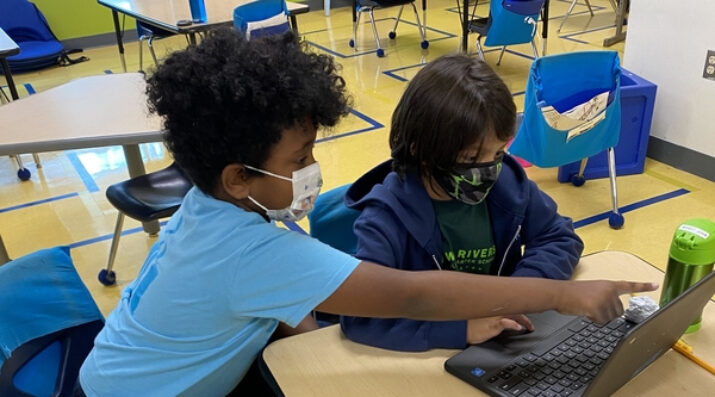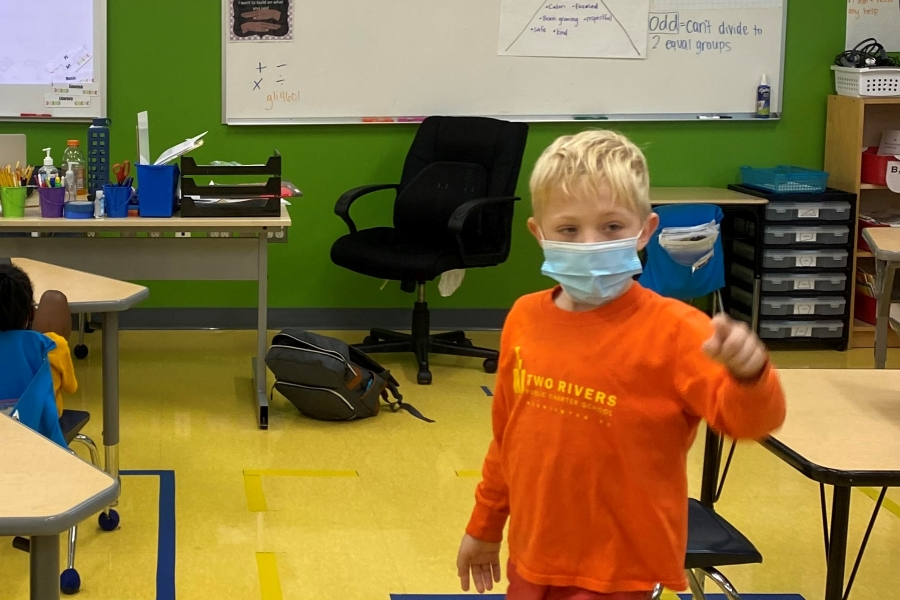New Designs for School
Classroom Structures that Promote Student Agency and Autonomy: The Power of Student Joy
Topics

We’ve all had the experience of truly purposeful, authentic learning and know how valuable it is. Educators are taking the best of what we know about learning, student support, effective instruction, and interpersonal skill-building to completely reimagine schools so that students experience that kind of purposeful learning all day, every day.
Teachers can use these four guiding principles to scaffold student agency and autonomy in the classroom, so that students experience the joy in knowing it's their classroom.
As one of my students sat down from presenting his Morning Meeting about Tamil, one of the languages spoken in India, I turned to the class and said, “Let me know if you’d also like to plan and lead a Morning Meeting. This is your classroom after all.”
Blank stares. Raised eyebrows. Agape mouths.
“What? Ms. Kelly, this is our classroom??”
“Wait Ms. Kelly, so this means we can do stuff?”
“So we can teach each other things?”
At this moment I realized we had a problem. My students were blatantly unaware that they had ownership in this classroom and of their learning. Without their voices and ideas, the classroom would simply be just a classroom; no student joy, independent thought, or investment in their learning. In my teaching career, I’ve come to understand this: students need to first feel safe, be heard, and experience joy before they can succeed. For students to feel this way, we as educators must create the structures that support student agency.
The social-emotional needs and curriculum tend to shift into second priority as the school year continues; data, assessments, and test scores dominate blocks in the daily schedule and PD discussions as time for joy, connection, and agency dwindle into the background.
Educators scaffold structures all the time whether it’s backward planning a unit or preparing for upcoming product showcases. Why can’t we apply this same practice to building student agency? Through backward design, educators can scaffold smaller structures that provide autonomy throughout the year in order to strengthen larger structures like student-led conferences and presentations of learning. Through intentional goal setting and student-designed and student-led Morning Meetings, students will not only develop as classroom learners but also as leaders outside the school building.
As I have considered how to best design for these experiences in my class, I developed four guiding principles based on what I’ve learned over the years. First, I want to make sure that there is a reciprocal culture of honest feedback and reflection. Second, I need to discover my students' passions. Third, I need to always be thinking about how I make the seemingly inaccessible, accessible. Last, but not least, I need to give choice to get voice. Continually reflecting on and returning to these principles have led to greater experiences for students to take ownership of learning in my classroom.

1. Create a Reciprocal Culture of Honest Feedback and Reflection
In order for students to understand that they can both give and receive feedback, I make sure to debrief everything from transitions in the hallway and math blocks to recess and Spanish. For example, after one of our literacy blocks last week, I shared my rating of 8/10. I explained that the transitions between centers met expectations and groups completed their independent work. I continued by also addressing how the class needed voice level reminders as well as redirections for how to ask for help.
The conversation didn’t stop there.
I passed the mic to my students who shared their own ratings of literacy and supported their rating with evidence and examples. Once everyone who wanted to share finished, we collectively agreed on the rating.
In order to foster an environment where students feel comfortable and confident in sharing their thinking, we must give space for them to provide their own feedback. Through a reciprocal feedback relationship, students gain more autonomy in their classrooms because they know their voices are valued.
2. Discover What They’re Passionate about
In one session of Number Corner, a math routine centered around finding patterns on the calendar based on whatever the month’s marker is, students observed different leaves and their attributes. When one student noticed a trend, he jumped out of his seat and exclaimed, “Oh, oh, I know what type of leaf that is!” He proceeded to share exactly what type of leaf was on the card and enlighten the class on just how many different species exist.
Did this connect to the lesson’s objective of identifying multiples of 3 and 4? No. Did it create excitement and wonder that permeated the room? Absolutely.
I used to tremendously struggle with off-task chatter. Students had to talk about the content, nothing else. I’m slowly shedding this mentality because I don’t want to dictate their thinking. Rather, I’m working toward truly honoring their curiosity. As mentioned earlier, students must feel safe, be heard, and experience joy before fully absorbing content. In an environment where students can safely share their interests and passions, they begin to invest more of themselves and their own inquiry into the learning.
3. Make the Seemingly Inaccessible, Accessible
Students usually view their teachers as the sole leaders and educators in the classroom. We need to empower them to not only help others, but to also see themselves as resources with expertise to share.
There’s a difference between when a student shares from their seat and when they stand in front of the room. They gain a new perspective. The student stands where the traditional classroom leader stands and delivers what I call their “expert knowledge” with us. I try to emphasize that I also genuinely learn something from them.
Earlier this week, one of my students led a Morning Meeting about space in which she informed us that Saturn’s rings aren’t actually rings but rather small gravitating clusters of rocks. I participated in her lesson, asking follow-up questions and commenting on her points. Students rarely view themselves as leaders in the classroom with something worthy of teaching to others. Their voices are important in designing a student-centered classroom.
4. Give Choice to Get Voice
Earlier this year during our Fairytales and Fables Unit, I noticed an overwhelming class affinity for two things: the Dogman series and creative writing. Aware of this, I shifted our end of unit task from all students writing a fairytale to students having the choice of writing either a fairytale or a fable but with themselves as the main character. When I shared this task with my students, you would’ve thought I told them we would watch movies in our pajamas for the rest of the week.
Their responses pushed me to realize how important and crucial it is for students to see themselves in their work. This not only sparks joy, but it also shows them that we’re listening. We see them.
When I was planning for this school year, my original plan was focused on scaffolding smaller structures in order to prepare students for larger ones: student-led conferences, showcases of learning, and end of unit products. However, the demands of this school year have tested me both professionally and personally. My students were not ready for content after the first six weeks. The school’s priorities centered on COVID safety and protocols. Teachers juggled learning brand new curriculum while also adjusting back to the high expectations set by the school leadership and school system. What I had originally planned and prepared for over the summer needed to shift after I realized what my students craved for after 18 months without the structure of the in-person school day, peer interaction, and consistency.
They needed joy.
Every teacher already implements structures that uplift student voices and creativity. My four principles respond to what my students need to succeed. Every classroom is completely different; you may create other experiences for your class based on their needs. However, I encourage you to give opportunities for students to voice their opinions and feedback, to explore topics they’re passionate about, to design and lead lessons whether it’s about snakes or subtracting on an open number line, and ultimately to see themselves as autonomous partners and experts in their own classrooms.
Photos courtesy of the author.




